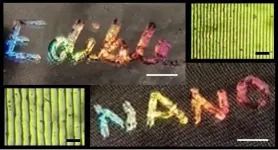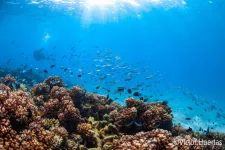(Press-News.org) The millions of people affected by 2020's record-breaking and deadly fires can attest to the fact that wildfire hazards are increasing across western North America.
Both climate change and forest management have been blamed, but the relative influence of these drivers is still heavily debated. The results of a recent study show that in some ecosystems, human-caused climate change is the predominant factor; in other places, the trend can also be attributed to a century of fire suppression that has produced dense, unhealthy forests.
Over the past decade, fire scientists have made major progress in understanding climate-fire relationships at large scales, such as across western North America. But a new paper published in the journal Environmental Research Letters details a study that takes this progress to the next level.
Researchers at five Western universities delved into which factors are increasing fire activity at the scales where management actions are implemented, and when and where ecosystems are likely to benefit from fuel management. They looked at data gathered across complex terrain in two mixed-conifer watersheds, in the Idaho Batholith and the Central Rocky Mountains.
Key findings include:
In one watershed, climate change was the key driver increasing burn probability and the frequency of large fires; in the other, fire suppression dominated in some locations.
Climate change increased burn probability and led to larger, more frequent fires in locations where soil aridity was relatively low.
In the most arid locations, climate change promoted drought stress and reduced fine fuel loads, which in turn reduced burn probability.
In intermediately arid locations, the effects of climate change and fire suppression varied in response to local trade-offs between flammability and fuel loading.
"This paper presents one of the first wildfire attribution studies at the scale of actionable management and shows that local responses to climate change and fire suppression can be highly variable even within individual watersheds," said lead author Erin Hanan from the University of Nevada, Reno.
Hanan is a researcher with the University's Experiment Station and Assistant Professor of Natural Resources & Environmental Science in the College of Agriculture, Biotechnology & Natural Resources. She and her collaborators at UC Merced, UC Santa Barbara, Washington State University and the University of Washington, Tacoma, used a novel modeling approach to examine how climate change and fire suppression influence fire regimes across watersheds.
Their approach integrates three research methods: (1) remote sensing data to characterize past fires; (2) climate models to determine the role climate change has played in local meteorological patterns, including temperature, rainfall and humidity; and (3) a watershed model that simulates how climate, water, vegetation and wildfire interact over space and time.
The scientists' work uses climate records developed through a National Science Foundation-funded initiative called FireEarth and a watershed model developed at UC Santa Barbara, and expanded through another National Science Foundation-funded initiative called SERI-Fire.
"This study is really the first to directly compare the independent effects of climate change versus fire suppression, which you can only do using dynamic models," said UC Merced Assistant Professor Crystal Kolden, who led the FireEarth initiative. "We were actually surprised that the climate change signal was so clear; that's kind of rare. And even though our study was limited to Idaho, the forest types and climate we modeled are found throughout the western U.S., so they are good analogs for many other watersheds."
In addition to illuminating the roles of major wildfire factors, the research also boosts methodology.
"This paper moves fire modeling and prediction forward by looking inside watersheds and disentangling the many factors that influence how fire regimes will evolve in the coming decades," said UC Santa Barbara Professor Naomi Tague, who led the SERI-Fire initiative.
While climate change remains a major factor, increasing the frequency and intensity of large wildfires across the globe, there are many regions where past suppression efforts still play an important role. Forest-density reduction is often the approach used in fuel-limited forests where decades of suppression have significantly increased fuel loads. However, density reductions sometimes have unintended consequences, particularly when vegetation growth is enhanced by the treatments, leading to greater plant water use, drier conditions - including drier fuels - and an increased fire risk.
Because fuel management often occurs at fine scales, spatially explicit models are needed to project how different areas within watersheds will respond to fire suppression or fuel treatments under the shifting conditions brought about by climate change.
"We found that the effects of climate change and fuels varied at fine scales within watersheds, and the relative influence of these drivers is changing as the climate continues to warm, so solutions to the growing wildfire problem must be adaptive and location-based," Hanan said. "That's why it's important to consider local environmental conditions and climate change trends in policy and management planning for the future."
INFORMATION:
Authors of the Environmental Research Letters journal article detailing the research project's results,
"How climate change and fire exclusion drive wildfire regimes at actionable scales," include:
Erin J. Hanan, Assistant Professor, Natural Resources & Environmental Science; University of Nevada, Reno
Jianning Ren, Postdoctoral Scholar; University of Nevada, Reno
Christina L. Tague, Professor, Bren School of Environmental Science & Management; University of California, Santa Barbara
Crystal A. Kolden, Assistant Professor, Management of Complex Systems, Gallo Management Program; University of California, Merced
John T. Abatzoglou, Associate Professor, Management of Complex Systems, Gallo Management Program; University of California, Merced
Ryan R. Bart, Assistant Project Scientist, Sierra Nevada Research Institute; University of California, Merced
Maureen C. Kennedy, Sciences and Mathematics, School of Interdisciplinary Arts & Sciences; University of Washington, Tacoma
Mingliang Liu, Assistant Research Professor, Department of Civil & Environmental Engineering; Washington State University
Jennifer C. Adam, Berry Distinguished Professor, Department of Civil & Environmental Engineering; Washington State University END
ROCHESTER, Minn. -- Mayo Clinic researchers have developed a novel proton therapy technique to more specifically target cancer cells that resist other forms of treatment. The technique is called LEAP, an acronym for "biologically enhanced particle therapy." The findings are published today in Cancer Research, the journal of the American Association for Cancer Research.
"The human body receives tens of thousands of DNA lesions per day from a variety of internal and external sources," says Robert Mutter, M.D., a radiation oncologist at Mayo Clinic and co-principal investigator of the study." Therefore, cells have evolved complex repair pathways to efficiently repair damaged DNA. Defects in these repair pathways ...
With the seemingly unstoppable advancement in the fields of miniaturization and materials science, all sorts of electronic devices have emerged to help us lead easier and healthier lives. Wearable sensors fall in this category, and they have received much attention lately as useful tools to monitor a person's health in real time. Many such sensors operate by quantifying biomarkers, that is, measurable indicators that reflect one's health condition. Widely used biomarkers are heartrate and body temperature, which can be monitored continuously with relative ease. On the contrary, ...
Holograms are everywhere, from driver's licenses to credit cards to product packaging. And now, edible holograms could someday enhance foods. Researchers reporting in ACS Nano have developed a laser-based method to print nanostructured holograms on dried corn syrup films. The edible holograms could also be used to ensure food safety, label a product or indicate sugar content, the researchers say.
Most holograms are imprinted with lasers onto metal surfaces, such as aluminum, but the materials aren't edible. For foods, holograms made with nanoparticles have been proposed, but the tiny particles can generate reactive oxygen species, which might be harmful for people to eat. In a different approach, food scientists have ...
ROCHESTER, Minn. -- A new study by Mayo Clinic researchers has identified that a chromosome instability gene, USP24, is frequently missing in pediatric patients with neuroblastoma, an aggressive form of childhood cancer. The finding provides important insight into the development of this disease. The study is published in Cancer Research, the journal of the American Association for Cancer Research.
"Neuroblastoma is a highly aggressive cancer that nearly exclusively affects young children," says Paul Galardy, M.D., a pediatric hematologist and oncologist at Mayo Clinic. Despite the use of multiple treatment approaches, Dr. Galardy says many children die of this disease every year.
To identify new ...
A mutation in the spike protein of SARS-CoV-2--one of several genetic mutations in the concerning variants that have emerged in the United Kingdom, South Africa, and Brazil--makes the virus up to eight times more infectious in human cells than the initial virus that originated in China, according to research published in the journal END ...
Scientists have discovered a never-before-seen biodiversity pattern of coral reef fishes that suggests some fishes might be exceptionally vulnerable to environmental change.
A new study shows plankton-eating coral reef fishes (planktivores) are far more diverse than others in the Indo-Australian Archipelago, a global marine biodiversity hotspot.
The findings highlight, for the first time, a unique link between the diet and distribution of species across the marine realm.
"The archipelago is one of the most complex and dynamic geological regions in the tropics," said lead author Dr Ale Siqueira from the ARC Centre of Excellence for Coral Reef Studies at James Cook University (Coral CoE at JCU). "And its ...
Teens who bully, harass, or otherwise victimize their peers are not always lashing out in reaction to psychological problems or unhealthy home environments, but are often using aggression strategically to climb their school's social hierarchy, a University of California, Davis, study suggests. These findings point to the reasons why most anti-bullying programs don't work and suggest possible strategies for the future.
"To the extent that this is true, we should expect them to target not vulnerable wallflowers, but their own friends, and friends-of-friends, who are more ...
UNIVERSITY PARK, Pa. -- Like a scene from a horror movie, tomato fruitworm caterpillars silence their food plants' cries for help as they devour their leaves. That is the finding of a multidisciplinary team of researchers, who said the results may yield insights into the abilities of crop plants -- such as tomato and soybean -- to withstand additional stressors, like climate change.
"We have discovered a new strategy whereby an insect uses saliva to inhibit the release of airborne plant defenses through direct manipulation of plant stomata," said Gary Felton, professor and head of the Department of Entomology at Penn State, noting that stomata are tiny pores on plant leaves that regulate gas exchange, including plant defensive emissions ...
Wheat straw, the dried stalks left over from grain production, is a potential source of biofuels and commodity chemicals. But before straw can be converted to useful products by biorefineries, the polymers that make it up must be broken down into their building blocks. Now, researchers reporting in ACS Sustainable Chemistry & Engineering have found that microbes from the guts of certain termite species can help break down lignin, a particularly tough polymer in straw.
In straw and other dried plant material, the three main polymers -- cellulose, hemicelluloses and lignin -- are interwoven into a complex 3D structure. The first two polymers are polysaccharides, which can be broken down into sugars and then converted to fuel in bioreactors. ...
Humans, like most social animals, tend to be organized hierarchically. In any group or social relationship there are always individuals who, for various reasons, significantly influence the behaviour of others. These individuals are attributed the highest status within the social group they belong to. As everyday examples of hierarchical relationships we find those of parents and children, teachers and students, bosses and workers, etc.
Given the pervasiveness of such social organization, in recent years studies have begun to ascertain how and when children begin to recognize which people have higher and which have lower social status. Specifically, ...




